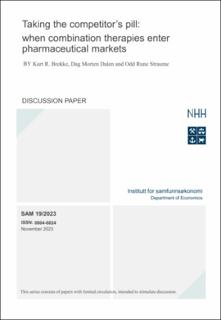| dc.contributor.author | Brekke, Kurt R. | |
| dc.contributor.author | Dalen, Dag Morten | |
| dc.contributor.author | Straume, Odd Rune | |
| dc.date.accessioned | 2023-11-22T08:35:25Z | |
| dc.date.available | 2023-11-22T08:35:25Z | |
| dc.date.issued | 2023-11-22 | |
| dc.identifier.issn | 0804-6824 | |
| dc.identifier.uri | https://hdl.handle.net/11250/3104002 | |
| dc.description.abstract | We study the competitive effects of combination therapies in pharmaceutical markets, which crucially hinge on the additional therapeutic value of combinatory use of drugs and the therapeutic substitutability with the most relevant monotherapy. With large additional therapeutic value, the introduction of combination therapies leads to higher prices and, somewhat paradoxically, may reduce the health plan's surplus. Although combination therapies imply that drugs become both substitutes and complements, we show that drug prices increase if the firms are allowed to coordinate their prices. Allowing for price discrimination might increase allocational efficiency, but only at the expense of higher purchasing costs. | en_US |
| dc.language.iso | eng | en_US |
| dc.publisher | Institutt for samfunnsøkonomi | en_US |
| dc.relation.ispartofseries | DP SAM;19/2023 | |
| dc.subject | Pharmaceutical markets | en_US |
| dc.subject | Combination therapies | en_US |
| dc.subject | Therapeutic competition | en_US |
| dc.title | Taking the competitor’s pill: when combination therapies enter pharmaceutical markets | en_US |
| dc.type | Working paper | en_US |
| dc.subject.nsi | VDP::Samfunnsvitenskap: 200 | en_US |
| dc.source.pagenumber | 38 | en_US |
